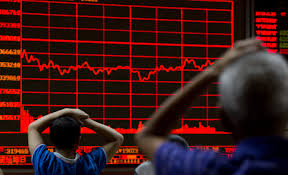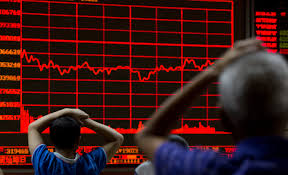
Igniting hopes that Beijing would cushion the slowdown with more stimulus policies following revelation of China's economy which grew at its weakest pace in a quarter of a century last year, there were rallies on the country's rollercoaster share markets.
Capping a tumultuous year that witnessed a huge outflow of capital, a slide in the currency and a summer stocks crash, growth for 2015 as a whole hit 6.9 percent after the fourth quarter slowed to 6.8 percent.
After a renewed plunge in China’s stock markets and the yuan stoked worries that the economy may be rapidly deteriorating, concerns about Beijing's grip on economic policy have shot to the top of global investors' risk list for 2016.
Industrial output for December missed expectations with a rise of just 5.9 percent, while electric power and steel output fell for the first time in decades last year, data from China's statistics bureau revealed. Illustrating how a slowing economy and shift to consumer-led growth is hurting industry, coal production also dropped for a second year in row, illustrating how a slowing economy and shift to consumer-led growth is hurting industry.
Disappointing those counting on the consumer to be the new engine of growth in China, December retail sales growth was also weaker than expected at 11.1 percent last month.
"While headline growth looks fine, the breakdown of the figures points to overall weakness in the economy. All in all, we believe that China will experience a 'bumpy landing' in the coming year," said Zhou Hao, senior emerging markets economist for Asia at Commerzbank Singapore.
Along with a growing expectation that more monetary easing measures were imminent, possibly before Lunar New Year holidays in early February, there was relief in the markets that growth at least matched forecasts.
further cuts in interest rates and the reserves that banks have to set aside were already looking "a foregone conclusion" before the data release, and now it was a question of timing, said Angus Nicholson, market analyst at IG in Melbourne in a note.
"That gives investors an excuse to buy stocks, after sharp falls recently," said Linus Yip, strategist at First Shanghai Securities Ltd.
Investors took their cue as the CSI300 index of the largest listed companies in Shanghai and Shenzhen gained 2.95 percent and pushed the benchmark Shanghai Composite Index up 3.25 percent by the close of trading.
After a series of sell-offs in the new year, the indexes remain about 14-15 percent down so far in 2016.
"We see this as a technical rebound. It's too early to say the market has seen its bottom, as we haven't yet seen a turnaround in the economy," said Yip.
While setting yuan’s daily midpoint fix at 6.5596 per dollar, the People's Bank of China (PBOC) did its bit to calm nerves by keeping the currency largely steady.
In a move that could raise the cost of wagering on further falls in the currency, which has lost about 5 percent since August, the currency move was followed by news of plans requiring overseas banks to hold a certain level of yuan in reserves.
While he expected more stimulus to the economy from the PBOC, the stability of the yuan, also known as the renminbi, was critical to maintaining growth, said Tommy Xie, economist at OCBC Bank in Singapore.
"This is a new risk for China. If the renminbi continues to weaken, the volatility and capital outflows get worse, then that is likely to pose a challenge to growth," Xie said.
(Source:www.reuters.com)
Capping a tumultuous year that witnessed a huge outflow of capital, a slide in the currency and a summer stocks crash, growth for 2015 as a whole hit 6.9 percent after the fourth quarter slowed to 6.8 percent.
After a renewed plunge in China’s stock markets and the yuan stoked worries that the economy may be rapidly deteriorating, concerns about Beijing's grip on economic policy have shot to the top of global investors' risk list for 2016.
Industrial output for December missed expectations with a rise of just 5.9 percent, while electric power and steel output fell for the first time in decades last year, data from China's statistics bureau revealed. Illustrating how a slowing economy and shift to consumer-led growth is hurting industry, coal production also dropped for a second year in row, illustrating how a slowing economy and shift to consumer-led growth is hurting industry.
Disappointing those counting on the consumer to be the new engine of growth in China, December retail sales growth was also weaker than expected at 11.1 percent last month.
"While headline growth looks fine, the breakdown of the figures points to overall weakness in the economy. All in all, we believe that China will experience a 'bumpy landing' in the coming year," said Zhou Hao, senior emerging markets economist for Asia at Commerzbank Singapore.
Along with a growing expectation that more monetary easing measures were imminent, possibly before Lunar New Year holidays in early February, there was relief in the markets that growth at least matched forecasts.
further cuts in interest rates and the reserves that banks have to set aside were already looking "a foregone conclusion" before the data release, and now it was a question of timing, said Angus Nicholson, market analyst at IG in Melbourne in a note.
"That gives investors an excuse to buy stocks, after sharp falls recently," said Linus Yip, strategist at First Shanghai Securities Ltd.
Investors took their cue as the CSI300 index of the largest listed companies in Shanghai and Shenzhen gained 2.95 percent and pushed the benchmark Shanghai Composite Index up 3.25 percent by the close of trading.
After a series of sell-offs in the new year, the indexes remain about 14-15 percent down so far in 2016.
"We see this as a technical rebound. It's too early to say the market has seen its bottom, as we haven't yet seen a turnaround in the economy," said Yip.
While setting yuan’s daily midpoint fix at 6.5596 per dollar, the People's Bank of China (PBOC) did its bit to calm nerves by keeping the currency largely steady.
In a move that could raise the cost of wagering on further falls in the currency, which has lost about 5 percent since August, the currency move was followed by news of plans requiring overseas banks to hold a certain level of yuan in reserves.
While he expected more stimulus to the economy from the PBOC, the stability of the yuan, also known as the renminbi, was critical to maintaining growth, said Tommy Xie, economist at OCBC Bank in Singapore.
"This is a new risk for China. If the renminbi continues to weaken, the volatility and capital outflows get worse, then that is likely to pose a challenge to growth," Xie said.
(Source:www.reuters.com)





